Introduction
In the rapidly evolving realm of software development, the integration of DevOps automation tools stands as a pivotal force driving efficiency and innovation. These tools not only streamline the development lifecycle but also foster collaboration between teams, ultimately enhancing the quality and speed of software deployment.
As organizations navigate a landscape characterized by increasing complexity and competition, understanding the significance of these automation solutions becomes essential. From reducing manual errors to facilitating rapid feedback loops, the advantages of DevOps automation are profound.
This article delves into the critical features of leading automation platforms, the challenges organizations face in implementation, and the future trends that will shape the DevOps landscape, providing valuable insights for businesses aiming to harness the full potential of automation in their operations.
Understanding DevOps Automation Tools: Definition and Importance
Software applications for continuous delivery are crucial applications intended to enhance and streamline different phases of the software development lifecycle. By facilitating improved collaboration between development and operations teams, these resources significantly enhance deployment speed and software quality. The significance of a devops automation platform in development and operations is emphasized by its ability to decrease manual tasks, minimize errors, and speed up feedback loops, thus promoting a culture of ongoing enhancement.
Notably, the average age of an employed DevOps engineer is 39 years old, indicating a mature workforce that can utilize advanced resources effectively. The devops automation platform facilitates the automation of repetitive processes—such as testing, integration, and deployment—enabling organizations to achieve greater efficiency, optimal resource utilization, and heightened customer satisfaction. In an environment where quick software delivery is a key competitive differentiator, understanding the functionality and benefits of a devops automation platform is essential for any organization aiming for success in today’s digital landscape.
According to Harikrishna Kundariya, CEO of eSparkBiz, 'Artificial Intelligence is what enables computers, robots, and other machines to replicate specific capabilities of human intellect such as learning, reasoning, recognizing objects, and problem-solving,' emphasizing the potential of AI in improving development operations. As emphasized in recent conversations, development teams are now increasingly focused on maximizing the value of their resources, enabling them to concentrate on more strategic aspects of development and operations. A compelling example of this is CloudZero, which provides insights into cloud costs, helping organizations manage their spending effectively.
Businesses such as Drift have saved $2.4 million each year on AWS expenses by leveraging CloudZero's services, showcasing the concrete advantages of DevOps resources.
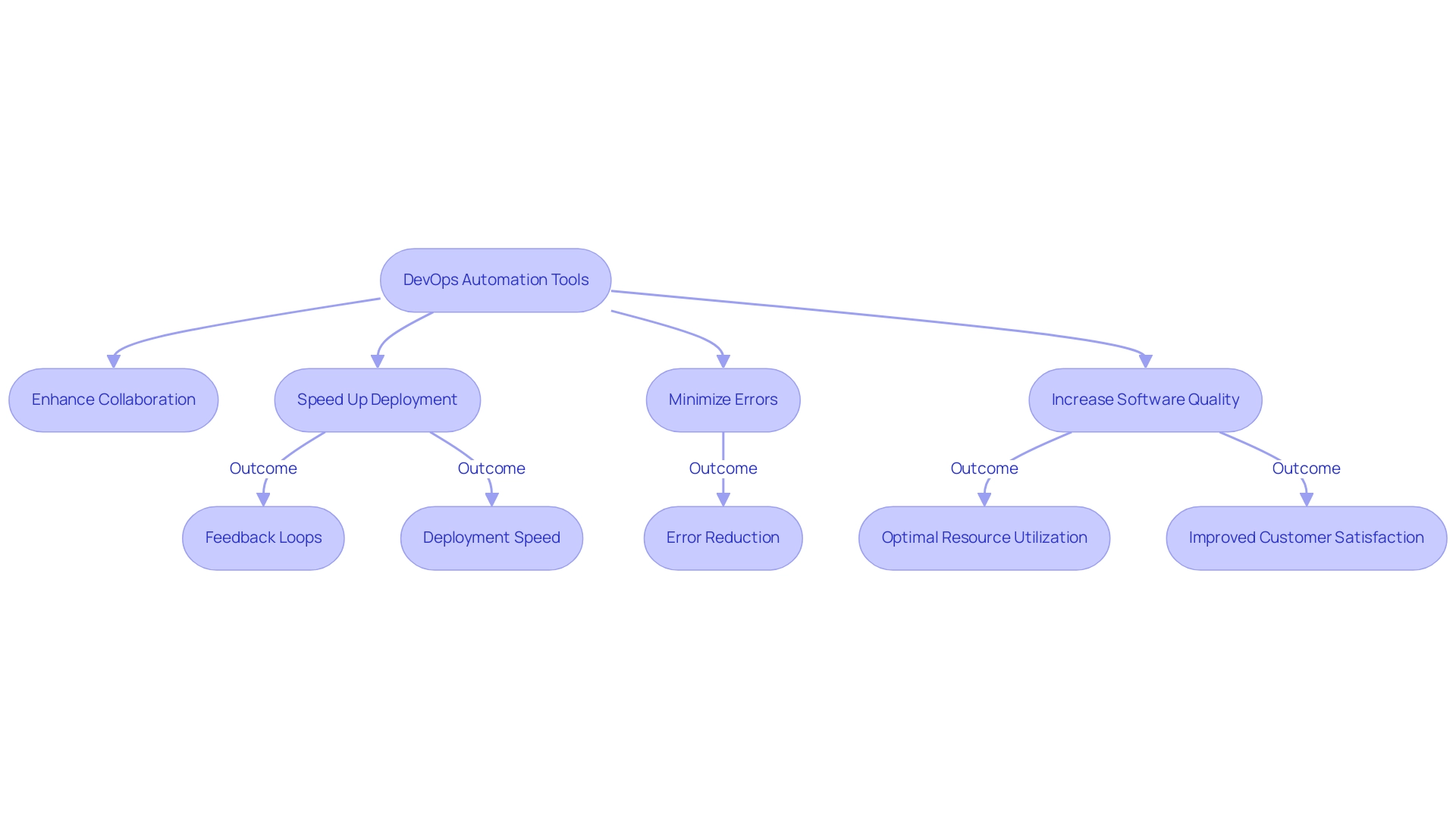
Comparative Analysis of Leading DevOps Automation Platforms: Features, Pros, and Cons
- Jenkins serves as a powerful open-source automation server within a devops automation platform, facilitating the building, deploying, and automating of software development processes. Its extensive plugin ecosystem enables smooth connection with a variety of resources and services.
Pros: The platform is highly customizable, features robust community support, and offers a wide range of plugins that enhance its functionality.
Cons: However, Jenkins often requires considerable setup and ongoing maintenance, which can be challenging for newcomers to navigate effectively.
- GitLab CI/CD Features: GitLab CI/CD combines integrated version control with continuous deployment capabilities, fostering enhanced collaboration among development teams.
Pros: Its straightforward setup process, built-in security features, and exceptional compatibility with GitLab repositories make it a popular choice.
Cons: Nevertheless, its flexibility is somewhat limited compared to standalone CI/CD tools, which may hinder its applicability for more complex workflows.
- CircleCI is a cloud-based devops automation platform that effectively automates the software development lifecycle, which includes building, testing, and deployment.
Pros: Known for its rapid performance, ease of connection with GitHub, and user-friendly interface, CircleCI is well-regarded in the industry.
Cons: However, pricing can escalate with increased project complexity, and certain features may be restricted in the free tier.
- Travis CI Features: Customized for GitHub projects, Travis CI offers continuous development and deployment solutions for both open-source and private repositories.
Pros: Its smooth connection with GitHub and straightforward setup using YAML files contribute to its ease of use.
Cons: On the downside, Travis CI offers limited support for non-GitHub repositories and may exhibit slower performance for larger projects compared to its competitors.
- Azure provides a comprehensive suite of resources that encompass project management, version control, and CI/CD functionalities.
It ensures seamless integration with Microsoft products and offers robust project management capabilities.
Cons: However, the platform can be overwhelming for smaller teams and may necessitate training for full utilization.
In conclusion, each of these devops automation platforms presents distinct features, advantages, and limitations. Organizations must carefully assess their specific requirements, team size, and existing workflows to choose the resource that aligns best with their strategic objectives. Significantly, North America was the largest area in the software solutions market in 2023, emphasizing the importance of platform selection in enhancing operational efficiency and project success.
As Claranet observed, the acquisition of Geko Cloud in Spain highlights the increasing significance of development and operations capabilities in the industry. Additionally, small and medium-sized businesses encounter difficulties in implementing agile practices because of a lack of skilled personnel, a tendency for conventional approaches, and the necessity for uniform resources, which should be taken into account when assessing solutions for streamlining processes.
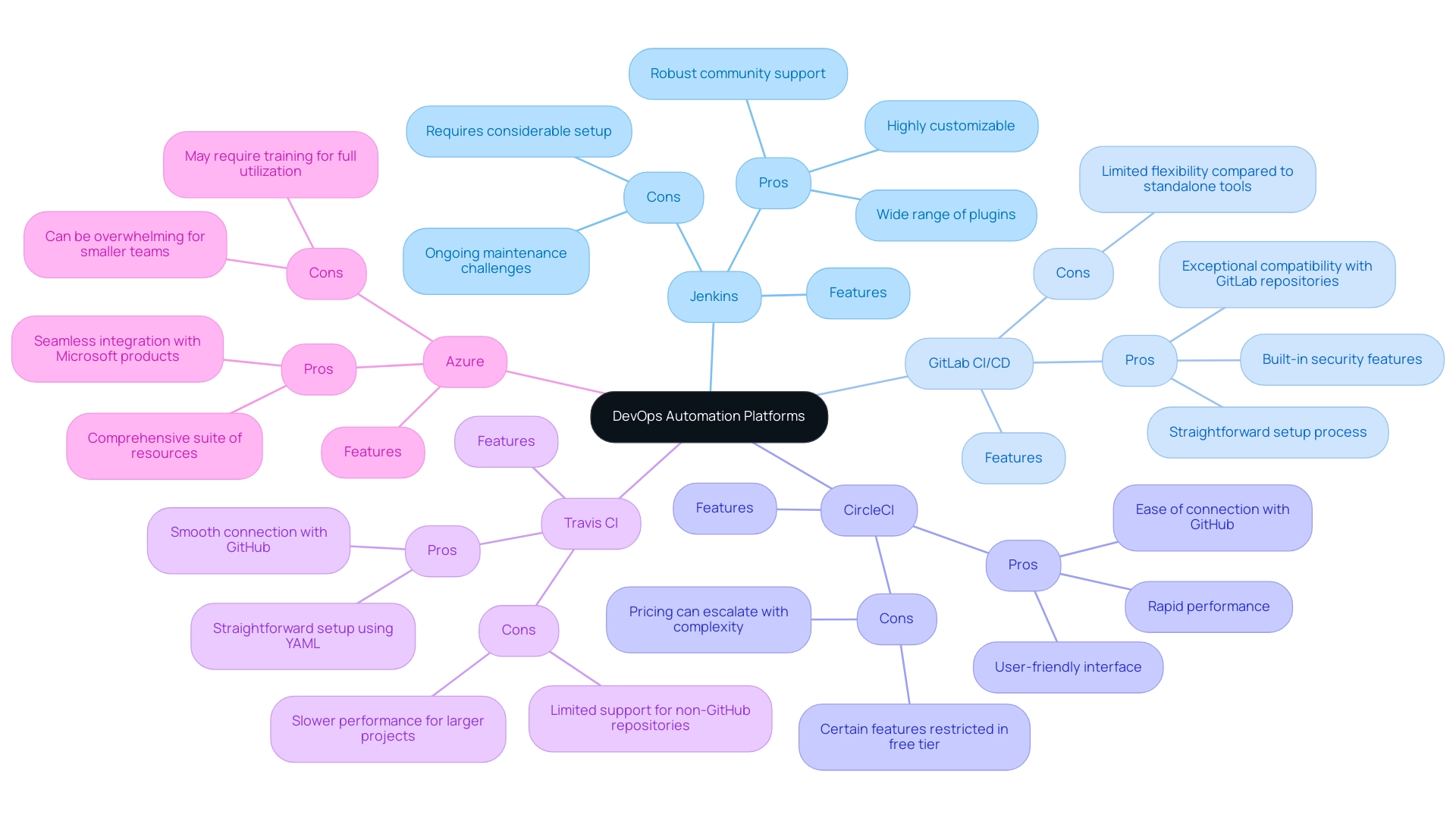
Key Features to Consider When Choosing a DevOps Automation Platform
When choosing an automation platform for development and operations, organizations should prioritize the following key features:
-
Connection Capabilities: Smooth connection with current tools and services is crucial for maintaining an efficient workflow. Platforms that enable a broad range of connections with crucial tools—such as version control systems, issue trackers, and cloud services—are essential, particularly given that over half of surveyed teams employ development and operations practices for container deployment. This statistic highlights the necessity for strong unification capabilities to ensure that workflows remain uninterrupted and efficient.
-
Scalability: As organizations grow, their development and operations processes must be able to scale effectively. It is crucial to choose a platform that can accommodate increased workloads and additional users without sacrificing performance, ensuring that growth does not lead to operational bottlenecks.
-
User Experience: A user-friendly interface significantly influences team adoption and productivity. Evaluate platforms based on their ease of use, customization options, and collaborative features that enhance teamwork.
-
Security Features: Given the heightened focus on data security and the alarming statistic that 50% of companies report that fulfilling access requests takes hours to weeks due to poor infrastructure access management, selecting a platform with robust security measures—such as role-based access control, encryption, and adherence to industry compliance standards—is essential for protecting sensitive information and ensuring efficient access management.
-
Support and Community: Strong community support and comprehensive documentation are invaluable resources for troubleshooting and learning. Platforms with active user communities often offer additional resources, plugins, and shared insights that can enhance the overall user experience.
-
Real-World Examples: Consider platforms that have demonstrated success in real-world applications. For example, the ChatOps case study demonstrates how efficient merging and mechanization can enhance operations by employing chatbot systems to manage inquiries, thus boosting operational efficiency.
By highlighting these attributes, organizations can select a devops automation platform that not only meets their present needs but also aligns with their future expansion and innovation strategies. As Mariusz Michalowski, Community Manager at Spacelift, states,
Mechanization is crucial for efficiency in development operations, and the appropriate tools can enable that change, especially through effective unification and mechanization strategies.
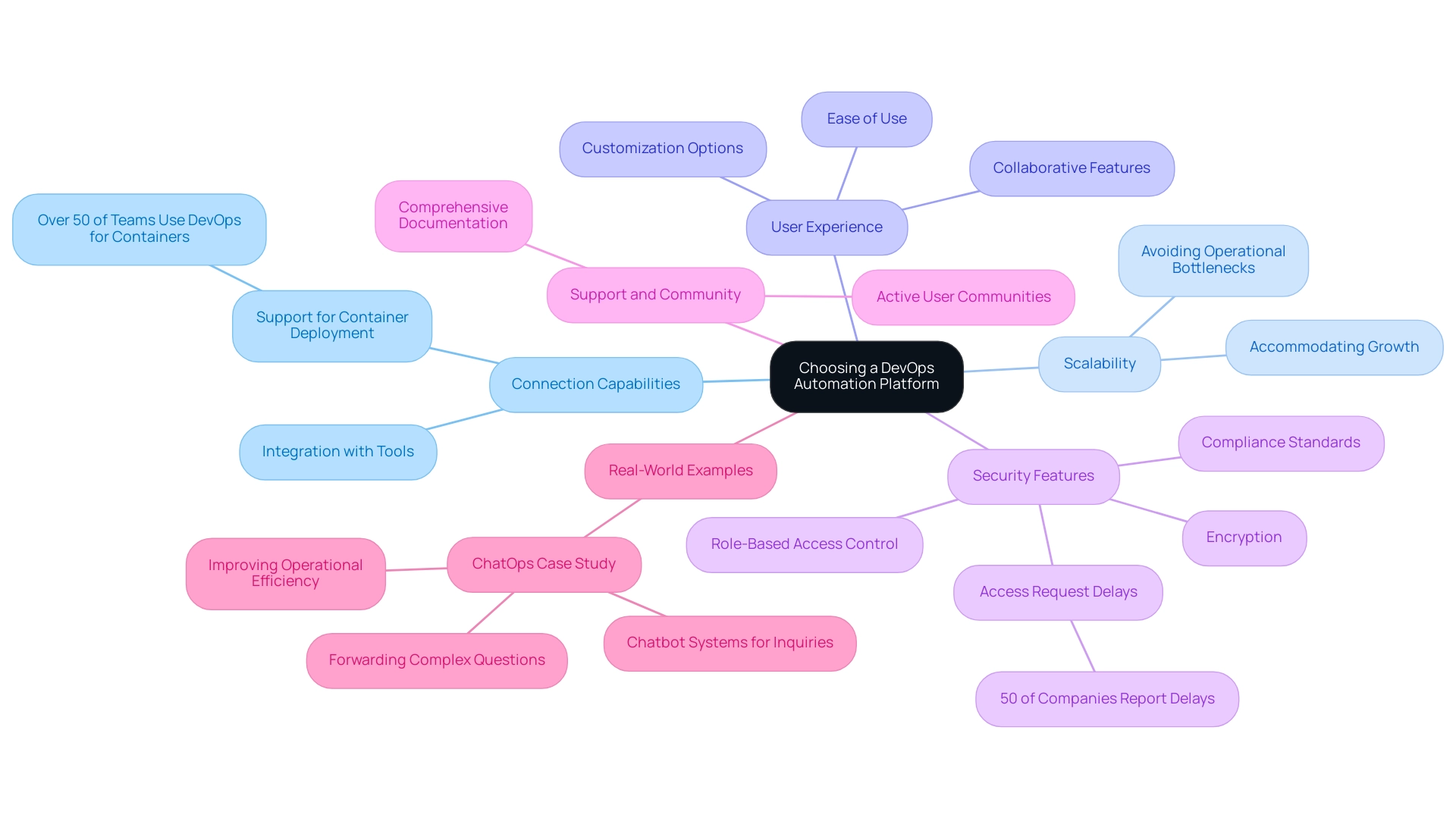
Challenges in Implementing DevOps Automation
Implementing automation in development and operations presents a multifaceted array of challenges that organizations must navigate to achieve successful integration:
-
Cultural Resistance: Transitioning to a collaborative culture necessitates a fundamental shift in mindset and teamwork among teams. A significant barrier arises from employees who are accustomed to traditional, siloed approaches. To effectively address this resistance, organizations should foster a culture centered on collaboration, transparency, and continuous learning. Notably, in 2022, 85% of organizations reported that embracing development and operations practices positively influenced their software security, indicating that overcoming cultural hurdles can yield significant benefits. The landscape of software development and operations is undeniably being reshaped by the emergence of GitOps, NoOps, and the intertwining of AI and machine learning, which further emphasizes the importance of embracing these cultural changes.
-
Resource Overload: The plethora of development and operations resources can result in confusion and inefficiency, as organizations frequently find it challenging to determine the best combination that suits their particular requirements. A pertinent case study shows that despite the extensive implementation of development and operations practices, only 30% of organizations can precisely monitor their cloud expenditures, emphasizing the real-world consequences of software overload. Careful evaluation and strategic selection of resources are essential to avoid the pitfalls of proliferation, which can complicate workflows and hinder productivity.
-
Skill Gaps: Successful implementation of a devops automation platform requires a workforce equipped with new skills and knowledge. Organizations may need to invest in comprehensive training programs or recruit skilled professionals who can effectively utilize these resources, thereby bridging critical skill gaps and enhancing overall operational efficiency.
-
Collaboration Difficulties: The incorporation of new mechanization resources with current systems can be intricate and labor-intensive. To mitigate these challenges, organizations should conduct thorough assessments of their current infrastructure and select tools that facilitate seamless integration, thereby streamlining the transition process.
-
Measuring Success: Establishing clear metrics to assess the effectiveness of development operations initiatives can be daunting. Organizations must define success criteria at the outset and engage in regular monitoring to ensure that their efforts remain aligned with overarching business objectives. Gartner has cautioned that expanding development and operations initiatives too quickly may lead to unproductive results, emphasizing the importance of a calculated and strategic method.
By proactively tackling these challenges, organizations can greatly improve their chances for successfully implementing development and operations processes, ultimately resulting in enhanced operational efficiency and a more agile reaction to market demands.
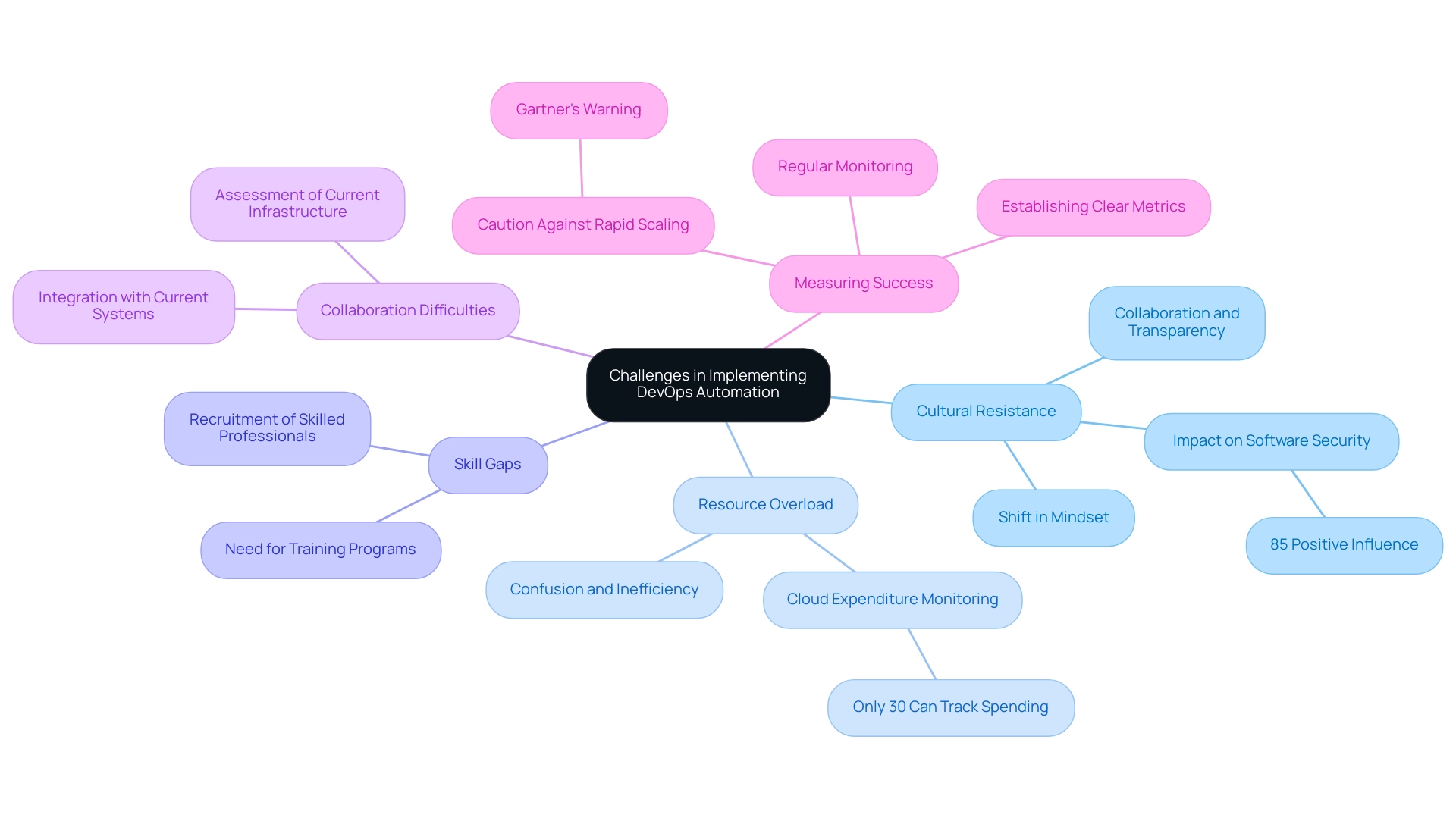
Future Trends in DevOps Automation
The terrain of development operations technology is consistently changing, influenced by several major trends that will determine its future:
-
Increased Adoption of AI and Machine Learning: Organizations are progressively harnessing AI and machine learning to improve efficiency and optimize workflows. These technologies facilitate the identification of patterns, enabling automated decision-making processes that significantly improve predictive analytics.
-
Focus on Security Automation: In light of escalating cybersecurity threats, integrating security into the development and operations process—known as DevSecOps—has become paramount. Companies are increasingly adopting security automation solutions to embed security measures throughout the development lifecycle, addressing vulnerabilities proactively. The Open Worldwide Application Security Project (OWASP) has cautioned that in 2024, issues such as data leaks and insecure plugins may pose serious security risks, underscoring the urgency of this trend.
-
Shift to Serverless Architectures: Serverless computing is gaining traction among organizations, allowing developers to concentrate on writing code without the burden of infrastructure management. This trend simplifies deployment and scaling, making serverless an attractive option for companies aiming to streamline operations and enhance efficiency.
-
Emphasis on Continuous Delivery: The demand for faster and more frequent software releases is propelling the adoption of continuous delivery practices. Organizations are focusing on a devops automation platform to automate the entire delivery pipeline, which enhances both speed and reliability, ensuring they can respond rapidly to market needs.
-
Collaboration and Communication Tools: As remote work becomes increasingly prevalent, effective collaboration and communication tools in software development are essential. Organizations are investing in solutions that enable real-time collaboration among distributed teams, ensuring alignment and informed decision-making.
As the market for development and operations is projected to grow by 25% annually between 2024 and 2032, remaining attuned to these trends will allow organizations to refine their strategies, capitalize on new opportunities, and maintain a competitive edge in a rapidly evolving market. However, the 2023 State of Development and Operations Report from Google highlights potential pitfalls, noting that many teams might implement AI without fully addressing the problems at hand or considering the implications for security and quality. Traditional software development and operations face challenges such as bottlenecks from manual procedures and mixed environments, which these emerging trends aim to mitigate.
As we move into 2024, the growth of security automation within the devops automation platform will be crucial for safeguarding against emerging threats. The successful implementation of AI-driven solutions, such as Microsoft's AI-driven code analysis, which reduced data leak probabilities and security threats by 25% within a year, exemplifies the tangible benefits of embracing these advancements.
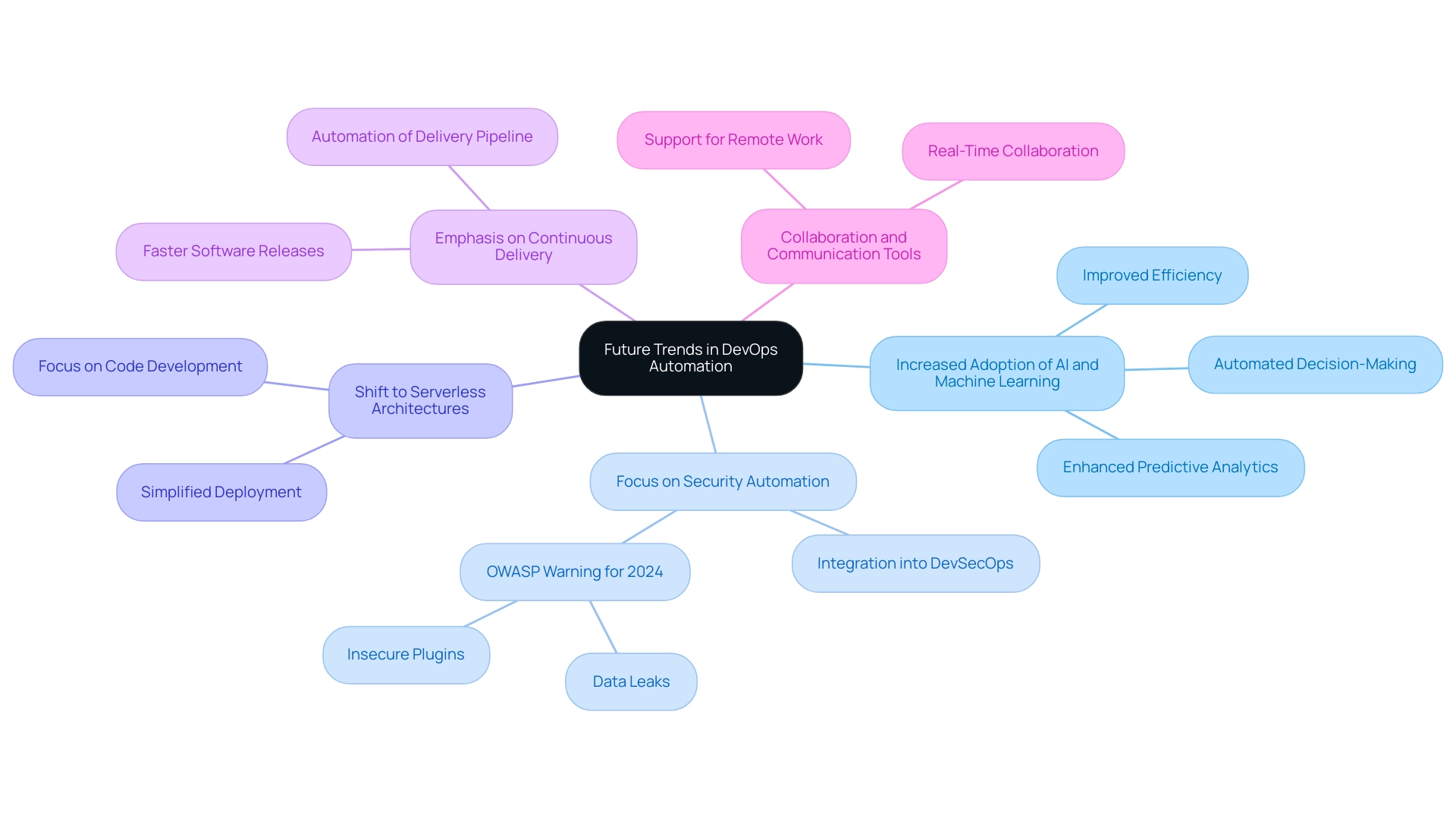
Conclusion
The integration of DevOps automation tools has emerged as a vital component in the software development landscape, driving efficiency and fostering collaboration across teams. By automating repetitive tasks, these tools not only minimize manual errors but also enable rapid feedback loops, ultimately enhancing the quality and speed of software deployment. Organizations that leverage these solutions position themselves to thrive amidst growing complexity and competition.
As highlighted in the comparative analysis of leading automation platforms, each tool presents unique features, advantages, and limitations that organizations must carefully evaluate against their specific needs. Key considerations such as:
- Integration capabilities
- Scalability
- User experience
- Security features
will play a crucial role in selecting the most suitable platform. Additionally, addressing challenges such as:
- Cultural resistance
- Skill gaps
- Tool overload
will be essential for successful implementation.
Looking toward the future, trends such as the increased adoption of AI and machine learning, the focus on security automation, and the shift to serverless architectures are set to reshape the DevOps landscape. Organizations that remain attuned to these developments will be better equipped to refine their strategies and seize new opportunities, ensuring they maintain a competitive edge.
In conclusion, the effective harnessing of DevOps automation tools is not merely a technical upgrade; it is a strategic imperative that can significantly enhance operational efficiency and responsiveness. As businesses continue to navigate an ever-evolving digital environment, prioritizing these automation solutions will be critical for sustained innovation and success.




